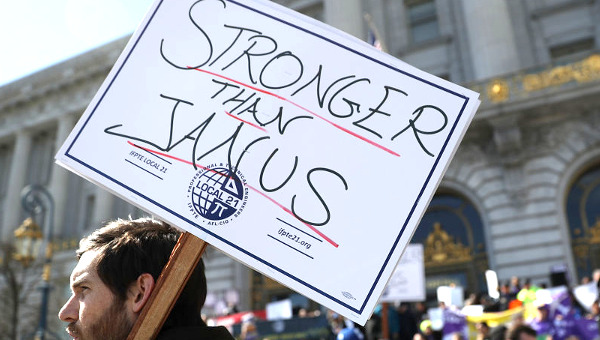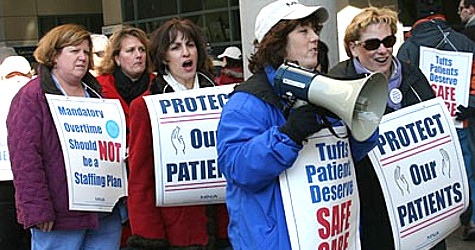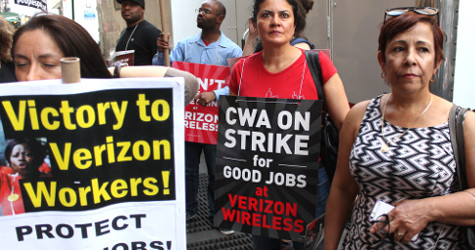Fragmentation in Toronto’s Hotel Sector
The intensity of the current conflict between UNITE HERE and its trusteeship of Local 75 and Unifor’s formation of a new local of hospitality workers (condemned by most of the labour movement as a raid) makes critical self-reflection and discussion especially difficult. In the essay below, Steven Tufts attempts to put this clash into perspective and offers ways forward that point to a unity beyond the current polarizing divisions in the sector. Tufts is a labour researcher with two decades of close association with Toronto area hotel workers, beginning with his PhD dissertation on HERE Local 75’s renewal beginning in the mid-1990s after the union emerged from an imposed international trusteeship. He has followed the union through its merger – and divorce – with UNITE which formed UNITE HERE in the mid-2000s. He remains an active supporter of its’ programs, such as the Hospitality Workers’ Training Centre and campaigns such as Fairbnb.
Many labour activists in Toronto – and indeed Canada – are well aware of the conflict between UNITE HERE Local 75 and the newly formed Unifor Local 7575. We know many of the leaders and activists on both sides, and the now open warfare is heart-wrenching. But analysis and positions need to be taken in terms of both the immediate issues and the less-discussed longer-term ones. As an insider/outsider who has followed hospitality workers for some time, I write this with the greatest respect for workers and unionists who are grappling with the challenges of anti-black racism, anti-democratic union practices, union competition, and rank-and-file mobilization that face the entire labour movement.
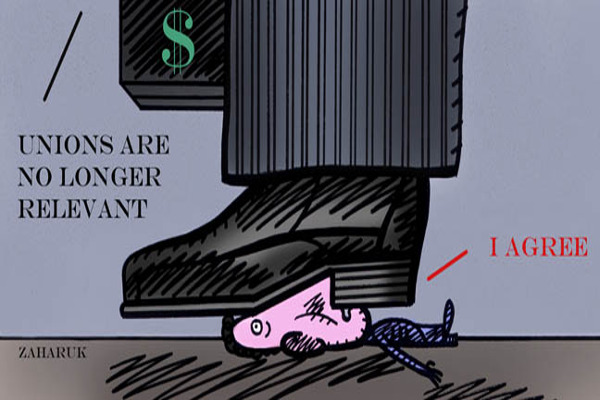
Over the last few weeks there have been condemnations of Unifor raiding UNITE HERE.1 There are further rhetorical pleas for a return to ‘unity’ and to redirect resources to ‘organizing the unorganized’.2 Indeed, for hotel workers – largely immigrants, women, and people of colour – raiding is an expensive distraction that divides workers and gives employers an advantage. What several of these commentaries fail to acknowledge is that in the current structure of organized labour, fragmentation is actually the norm and unity is the exception. Fragmented union representation in the hotel sector is a prime example of this reality and has been this way for some time.
Local 75’s Escape from Mob Influence
It is useful to recall the recent history of hotel worker unionism in the Toronto area. Airing Local 75’s dirty laundry from so many years ago shows how far hotel workers have come in the city. In the 1980s, the CBC’s Fifth Estate aired a documentary featuring James Stamos (Canadian Director, HERE) and Jean-Guy Bélanger (President of Local 75 from the mid-1970s until the imposed trusteeship in the mid-1990s). The documentary highlighted the union’s affiliation with the Cotroni crime family in Montreal.3 Corruption and violence in Local 75 were not uncommon.4 One-time organizer and associate of Bélanger, Canadian boxer Eddie Melo, once pulled a gun on a rival union officer. Melo himself was assassinated in a Mississauga parking lot in April 2001.5
Local 75 fits the larger historical experience of organized crime infiltration and corruption in HERE. The international union was placed under U.S. Supreme Court monitoring in the mid-1990s, resulting in a report with so much documented corruption that Ed Hanley’s 25 year presidency of the union finally came to an end in 1998.6 HERE emerged from direct court administration in the early 2000s, but UNITE HERE still remains subject to federal oversight in the USA.
During this transitional period (and well after) several Canadian Labour Congress (CLC) affiliates raided what is now UNITE HERE Local 75. For almost twenty years, Bélanger was partly protected from full scale raiding by the CLC despite his reputation for financial impropriety and links to organized crime.7 As UNITE HERE began to clean house in the 1990s and undergo a transformative program from where it was at, leaders such as Bélanger were ousted. Bélanger, according to my interviews at the time, was dealing with personal gambling debts by failing to remit all union dues. He also attempted to ‘sell’ the Local to the UFCW by orchestrating a raid on their behalf. When the trusteeship successfully defeated his raiding attempts in the mid-1990s, UFCW refused to pay him. Bélanger successfully sued UFCW in Quebec court and won $200,000 plus interest in a 1999 settlement.8
Fragmentation and Raiding in the Hotel Sector
Other unions have also competed for hotel workers in Toronto and the sector is not solely represented by Local 75. Although representing a smaller number of workers, these unions include UFCW, USW, SEIU, LIUNA, IAM, Unifor (prior to the formation of Unifor 7575), and some other small unions. Over the years, some of these unions have sought hotel workers represented by Local 75 either through proposed mergers or raiding. For industrial unions facing a shrinking manufacturing membership base, hotel workers are enticing. After all, hotel jobs are not easily shipped overseas. The recent condemnation of Unifor’s raid by the USW National Director of Canada suffers from selective amnesia of his own union’s history in the sector.9 Local 75 also represents members in the university foodservices sector and there have been disputes with CUPE over representation in these workplaces.
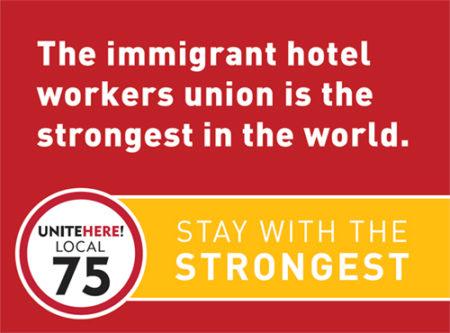
Here, a major paradox confronting organized labour in Canada is exposed when it
comes to raiding. On the one hand, raiding is often politically corrupt as it consumes resources that should be spent on organizing the unorganized. The practice also is not effective and rarely results in any large scale changes in affiliation. When workers do choose to leave one union for another, it is usually only when they have dire concerns. On the other, the raids launched on Local 75 in the 1990s forced the international union to act and insert local leadership to put the union on a path of renewal. In specific contexts under labour’s current structures, trusteeships and raiding are inefficient but necessary evils within the house of labour. Yet this also brings with it divisive competition among unions and fragmentation in many sectors.
In the mid-2000s, HERE entered a short-lived merger with UNITE throughout North America. The formation of UNITE HERE made sense on paper as one union had financial resources but a membership base in a dying textile industry, while the other was expanding into hospitality but had limited resources. The merger turned sour, however, and the UNITE half of the merger formed Workers United and affiliated with the SEIU. Once again, another fight ensued as HERE and UNITE engaged in a battle over the union’s members.10 Even though UNITE HERE Local 75 dominates the hotel sector in Toronto, union representation remains fragmented in the city and much more so across Canada.
The Trusteeship and the Raid
Today, hotel workers find themselves in the midst of another conflict. This time it has ramifications for the entire North American union movement. A split in Local 75 had one faction supporting the UNITE HERE trusteeship of the local which removed several elected leaders, including the president and supportive shop stewards. On the other side are the fired elected leaders and staff supporters who have left to form a new local, Unifor 7575. As a result, Unifor, the largest union of private sector workers in Canada, disaffiliated from the CLC avoiding inevitable sanctions for raiding. Within Unifor there has been dissent against the unilateral decision of the National Executive Board lead by Unifor president, Jerry Dias, and in turn creating even further divisions in the labour movement.11
The reasons for the split and the emergence of two factions in Local 75 are complex. Currently, there are two polarized perspectives that are being played out in social media and in the cafeterias of many Toronto hotels. On one side is the pro-trusteeship faction largely made up of Executive Board members and some staff, led by Secretary-Treasurer Nuredin Bulle. For well over a year, the group made formal complaints and serious allegations of racial, sexual, and other forms of intimidation and harassment against the now deposed leadership. The group went without formal endorsement from the general membership to the International and asked for the Local to be trusteed, claiming it was dysfunctional and could no longer operate. Indeed, the faction itself organized a boycott of Executive Board meetings which actually halted union business and gave the International its initial justification for the trusteeship.
The other faction consists of the now deposed leadership and supporters who left to form Unifor 7575. Their claims are that the allegations are either exaggerations or false, part of a play to subvert democratic processes and to seize control of the union which intensified from the spring of 2017. They highlight investigations prior to the trusteeship in which the International itself found that many allegations were unsubstantiated. In some cases, statements from members of the pro-trusteeship faction themselves dismissed the various allegations. Further, those who have now formed Unifor 7575 claim that the pro-trusteeship faction cooperated with the International to depose Lis Pimentel, first elected as Local 75 president in 2012 and acclaimed for another term in September 2016. Pimentel had been critical of the direction UNITE HERE was taking as it prepared for international bargaining and of the lack of resources being spent in Canada.
Conflicting Narratives
Much of this battle can be seen in the factums and documents produced for the legal fight over trusteeship. Unifor 7575 has posted documents from both sides on a website for those who have the time to sift through hundreds of pages.12 Local 75 followed with posting documents with their account of the events.13 The narratives and counter narratives are the propaganda arms of the current war between the two unions. (I imagine that several labour studies theses will examine this conflict and its documentation for several years to come.)
But how can people on the ‘outside’ of this battle figure out who and what to believe? Racism and sexism are embedded in all institutions and labour unions are no different. It is not plausible that a significant group of unionists would simply conspire to make specific claims of anti-black racism and harassment to remove top leaders and take over the union. Racism is power and power acts. So how was power engaged in practices that had a negative impact on those Executive Board members and staff who made the complaints? The claims include racist hiring decisions, unfair workload assignments, dismissals, sexual harassment, and intimidation the details of which are disputed. Determining a single absolute ‘truth’ is all but impossible at this point, but discounting anti-black racism and the failure of top leaders to deal with these issues is problematic.
It is important to acknowledge that racial divisions in UNITE HERE leadership have been noted for some time. The international union since the 1980s has recruited primarily white activists from high-ranking U.S. universities, especially Yale, where UNITE HERE Local 33 represents graduate employees. Local 75 Past-president Paul Clifford and Pimentel herself have links to Yale. Other activists have also been recruited from outside of the hotel sector. In the USA and Canada, UNITE HERE has also actively recruited leaders directly from the rank-and-file. In many cases these rank-and-file activists, often women from racialized immigrant groups, became staff or were elected top leadership positions in Local 75. As a result of these different pathways of leadership recruitment, there are divisions in leadership that cross lines of race, gender, class, and sexuality. While these divisions of labour and power do not fall uniformly along racial lines, the position of local president, some top leadership positions, and a majority of researchers and campaigners, have been predominantly white with other staff positions filled from people of colour drawn from the rank-and-file.
Such divisions between organizers hired from universities (some with significant technical skills and often legal experience), and others from the rank-and-file are something that UNITE HERE has struggled with since the 1990s renewal period. Indeed, much of the union renewal literature itself deals with such contradictions of representation in multi-racial sectors. When I initially explored these issues fifteen years ago, white leaders expressed a clear awareness of the contradictions of highly educated, white people representing people of colour. They had two stock responses.14 First, a traditional socialist position, that if white [male] leaders are dedicated to fighting for workers and respect differences, they could be effective. Second, that leadership will eventually become more diverse and reflect the membership, but it takes time to develop new leaders. (Indeed, the leadership of Local 75 was predominantly people of colour well prior to the recent trusteeship.) Black staff interviewed at the time also recognized the power and complexities of racism and the challenges of a representative leadership:
“I’ve gone to the international convention and there was one person that had a position who was not white. That was Maria Elena [Durazo]. And, my God, you can look around the room and you can count the [large] number of black people who were there, and women. And Maria was the only person who wasn’t white who had a real position as one of the top guys. I think it is another lifetime before there will be real change. It’s not going to happen overnight.”15
In the case of Local 75, underlying tensions and racism among members and staff are not new. The tensions did, however, concretize dramatically over the last year, and the two factions developed. One side led by black leaders and staff took over the Executive Board and challenged Pimentel. The characterization of these factions is, however, general rather than absolute as Pimentel had the support of some black members and staff, and the Local 75 faction had support from non-black workers.
At the same time, Pimentel has also been known as a progressive leader within UNITE HERE for almost two decades. She has challenged Donald ‘D’ Taylor, the International President elected in 2012, on several issues including cost-cutting measures implemented in 2016. (Pimentel also admittedly favored progressive labour activist Maria Elena Durazo for International President.) There are claims that Taylor is pivoting UNITE HERE away from a more aggressive leadership development organizing model to a more defensive, pragmatic position in the Trump Era. Unifor 7575 leaders claim that the International wanted an early end to a strike of UNITE HERE Local 75 workers employed by Aramark at York University in early 2017. The international union was reportedly in discussions with the company seeking a broader deal. The successful strike was an important win in Ontario and set the tone for the ‘Fight for $15’ campaign that summer. Like other U.S. unions, the International may be saving resources as U.S. unions prepare for the Supreme Court decision in Janus v. AFSCME, a case that may usher in ‘right-to-work’ across the entire country. UNITE HERE may also shift resources to the Democratic Party for the 2018 elections as it has been able to swing voters in Nevada and California.16 Shifting the balance of power in Congress and stalling Trump’s attack on immigrants is an important issue for UNITE HERE’s membership. These changes in strategic direction are driven by the U.S. context.
More important, the above approach echoes what Richard Yeselson, a past UNITE HERE researcher and strategist, has termed ‘Fortress Unionism’ – the retreat to strategic organizing in union strongholds until an unpredictable ‘bottom-up’ resurgence once again seeks mass unionization.17 If Taylor is shifting to retrenchment, removing a dissenting leader would send a message to any other dissenting larger locals.
A few of the key leaders of the pro-trusteeship faction no doubt think that it is their time to assume control of Local 75. These officers and staff are no different from anyone else seeking power and such ambition would only be heightened if leadership decisions in the organization are being seen as shaped by anti-black racism. As foreshadowed by the staff member quoted above, it is reasonable to have the expectation that now is the time for a non-white leadership emerging from the rank and file. It is possible to speculate that Pimentel and others were slated, as is so often the case in union bureaucracies, to move on to other positions in the union and open up space for some of the pro-trusteeship leaders to take on the top roles. In resisting the direction of Taylor, however, the Local 75 leadership stalled everyone in their current positions within the local’s structure.
At the very least, these political battles in Local 75 are complex, cross-cutting and in no way resolvable within a single local itself. It is crucial to move any analysis of the internal conflict away from polarized narratives. Struggles against systemic racism and intimidation can be co-opted into processes that subvert local union democracy. They are not mutually exclusive. Pimentel and others in Local 75 obviously failed to change their practices and address issues of anti-black racism adequately to resolve the conflict. The intervention by the International to mediate also clearly failed and, ironically given present divisions, possibly even heightened the tensions. Conflicts stem from systemic racism that reproduces specific divisions of labour and power in the Local and the entire union. But it is also possible to claim the Executive Board members and staff opposing Pimentel worked with the International to depose her – perhaps for different political purposes. Interestingly, the ‘dysfunctionality’ of the Local is emphasized as the justification for intervention with racism as an aside rather than direct cause.
Members Matter
In any case, the appropriateness of the trusteeship must include the evaluation of rank and file members as a whole. Clearly the Executive Board was largely against Pimentel. The members, however, were not as united against her leadership. In April 2017, the pro-trusteeship faction, again led by Bulle reportedly stacked a GMM with 80-90 members and refused to pass the budget and other union business. At the next GMM on July 17, Pimentel and her supporters were able to get over 700 members to the meeting (very significant in a non-bargaining year). Not only did the members pass the items from the previous meeting, but they also ‘overwhelmingly’ passed the following resolution:
“We the members of UNITE HERE Local 75 oppose any request made by anyone that a trusteeship be imposed on UNITE HERE Local 75.”18

Despite the resolution, the International did grant Taylor the power to trustee the Local in early December. Trusteeship was imposed on January 6 and a meeting was held under the trusteeship three days later where Pimentel was essentially fired. At the meeting, another 80-90 pro-trusteeship supporters (which included the many organizers brought in by the trustee assigned by the International) rejoiced. However, Pimentel held a counter GMM across the street with over 400 supporters re-affirming her leadership and passing a motion to fight the trusteeship in court.
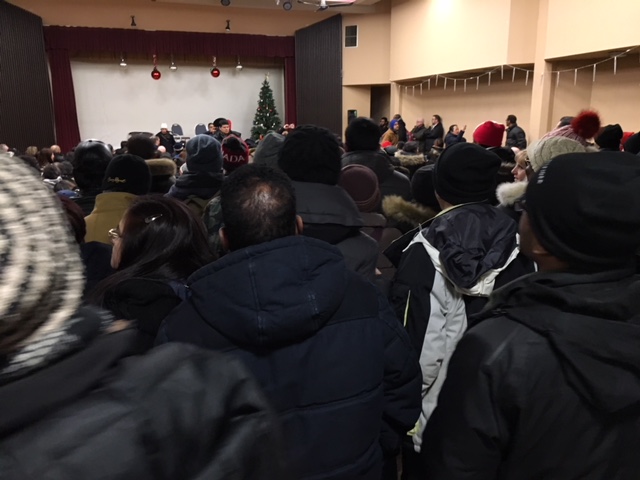
Shortly thereafter, Pimentel and her supporters made a choice to seek the support of Unifor (with the Canadian labour centrals offering no real recourse of mediation for locals in a conflict). Even if able to challenge successfully the International’s violation of its own trusteeship processes in court, the final hearing would not have been until June 2018. Further, administering a local starved of resources, ostracized by the International after a court battle, and still having a divided Executive Board was hardly optimal. Pimentel and her supporters decided to give members the choice of staying in the trusteed Local or leaving for the newly created Unifor Local 7575. In this setting, Unifor was a logical choice given that it has a significant membership in the hospitality sector in Canada and a willingness to challenge the CLC’s anti-raiding policies. The decision was not taken lightly and for some was painstaking given their long tenure with UNITE HERE. It was a calculus that hotel workers would be better served in a union that was autonomous from the U.S. union’s pivot to the right under Taylor and the pro-trusteeship leaders that would likely take power.
Unifor and the Raid
Unifor’s decision to intervene in Toronto as hotel workers responded to the trusteeship was immediately and quite generally condemned, with many union activists taking it for granted that, as in the case of Unifor’s botched attempted raid of the Amalgamated Transit Union (ATU) [see Bullet No. 1382] local for the City of Toronto, the raid was planned well before the International’s imposition of the trusteeship. In this case, the raid of Local 75 was a response to the trusteeship – even the International’s own court documents made no charge of prior Unifor intervention. In fact, UNITE HERE was most likely caught by surprise, given there was only a small window before the open period in 25 hotels closed at the end of January 2018.19 Moreover, unlike the ATU raid, this time Unifor was invited in by a displaced president with significant membership support.
But to make matters even more contentious and complicated, Unifor President Jerry Dias inexplicably left the CLC without challenging the trusteeship within the central body’s structures and without getting an endorsement for leaving the CLC from his own union members. Leaving the CLC was not necessary to proceed with the raid and not bringing his members into the decision contradicted the emphasis Dias placed on worker democracy as he attacked the Local 75 trusteeship. The disaffiliation from the CLC meant exclusion from local labour councils and this added to the criticisms from those members who treasured their links with other local activists through those structures. While Unifor did have to act quickly if it wished to displace workers in Toronto given the open period was soon ending, there were avenues of seeking broader support from members who are now questioning the decision to disaffiliate.
Dias has long held suspicions of U.S. international unions invoking trusteeship as a means of stifling legitimate dissent. Admittedly, the ‘Canadian national question’ is always implicated in this, and is something that still animates Unifor politics. Unifor also has a significant number of members in the hospitality and gaming sectors across Canada and a foothold in Toronto would cement a place in the sector. The union’s plan to organize casinos across Canada would be better facilitated by the experienced researchers, campaigners, and organizers now employed by Unifor 7575. However, after the fiasco with the ATU local, this was unlikely enough to convince Dias to assist Pimentel. For Dias to sign-off knowing the allegations against leaders and the implications for the union’s relationship with the CLC, he would have needed to know that this is what many hotel workers wanted. Taylor’s anti-democratic actions and the ability of Pimentel to get members to meetings to voice opposition was evidence enough. But with open periods soon ending in key hotel properties and quick settlements in upcoming bargaining possibly closing the open periods for close to three more years, the question was whether or not Unifor 7575 could mobilize displacement votes before any consolidation of the Local 75 trusteeship.
The decision to create Unifor 7575 passed an initial first test. A number of displacement votes were filed despite the compressed time frame. For many unions, a common threshold for a certification vote is 70 per cent of cards signed before filing. Under Ontario labour law, displacement votes have limited time periods unlike an organizing drive so the threshold is often lower. Yet, a number of Local 75 members did choose to join Unifor 7575. In 10 days, Unifor 7575 signed up 800-1000 workers in 4-5 properties. The final tally may be delayed as a number of ballot boxes are currently sealed until the Ontario Labour Relations Board settles outstanding issues with the votes. Unifor 7575 leaders did, however, make an initial raid sting.
Pimentel and her supporters were challenged effectively by the Executive Board and the International, but they maintained relationships with enough members through the leadership/committee structure. The trustees also replaced shop stewards supporting Pimentel. This anti-democratic tactic combined with the membership being trusteed, despite the GMM resolution passed in July, obviously riled some members. The imposition of trusteeship in this manner was perceived as a threat to local union democracy and was simply more disturbing to some than the now publicly known allegations of racism and harassment against the Unifor 7575 leaders. This in no way exonerates any systemic racism and sexism within the union, but it does place such power relations in a more complex political context.
Taylor obviously knew that the pro-trusteeship faction lead by Bulle controlled the Executive Board but that it did not have the full support of the membership. If he felt the faction had the members, he would have allowed Local 75 to hold an early election. In fact, Pimentel, whose term did not end until 2020 offered to do just that, but Taylor would not authorize a vote. If Pimentel won with a new slate on the Executive Board, a stronger mandate would have allowed her to oppose Taylor’s agenda – even when starved of resources. Instead, Taylor forbid an election and allowed the tensions to rise to a point where he could trustee the Local. He then forced Pimentel and her supporters into a corner and perhaps underestimated their willingness to engage in a full-scale war within the confines of another union in such a short time frame. Taylor delayed formal trusteeship for over a month to minimize the number of days before the expiration date of key collective agreements. Although he was obviously prepared for a delayed fight in the courts, it is doubtful he anticipated an immediate departure and raid by key leaders and long-time staff with only two weeks remaining in the open period. Under Taylor’s leadership UNITE HERE now finds itself in a resource intensive anti-raiding battle (one that may be hard to keep confined to just one city in Canada) over a relatively small number of members with top organizers trapped in Toronto. (Any past claims that UNITE HERE was draining resources from Canada no longer ring true.)
In terms of the past history of Local 75, the decision of a faction to turn to Unifor at this juncture is understandable. First, UNITE HERE Local 75’s previous success was largely embedded in its multi-scalar strategic orientation that links membership mobilization with campaigns tailored to the hospitality sector and supported by local and national levels within the organization.20 The International’s withdrawal from leadership development and member mobilization coupled with international pattern bargaining to a lower common denominator diminished its attractiveness in the eyes of those who feel they have enough capacity and power in Toronto. International sector-based unionism was no longer perceived as the only or best means of organizing hotel workers, and Unifor was now a viable option in an already fragmented sector.
Second, Pimentel, many of her supporters, as well as many pro-trusteeship leaders in Local 75 are simply comfortable in a warzone. Union power has been built through a long culture of struggle against mob control, countless raids from CLC affiliates, another union following a failed merger, and large corporations who make hotel workers struggle for every single penny and dignity in the workplace. Now that same fighting culture is fueling a raiding war. Hospitality rank-and-file activists, staff, and leaders (who have often also fought for their own jobs in these conflicts) are battle hardened as they engage in endless wars of position and manoeuvre. While comfort in the battlefield is a source of great strength, it can also lead to great destruction.
Undoubtedly, there will be those who explain any member support for Unifor 7575 as limited, a function of leader manipulation of the committee structure, the hangover of recent successes in bargaining gains for hotel workers under Pimentel, and anti-Black racism among the membership itself (with other workers of colour often the implicit targets of these claims). Support for Unifor 7575 in the displacement votes thus far does not fall along strict racialized lines. Dismissing the support of racialized members and staff for Unifor 7575 as a product of a ‘colonized mind’ is just as problematic as discounting any role of racial hierarchies and white supremacy in unions. If the International and pro-trusteeship faction’s strategy was to replace Pimentel and her supporters effectively, they needed to engage the membership in full discussions of anti-black racism and harassment among the leadership. As they failed to reach out in this way, many members questioned the union’s commitment to local democracy to the point where the Local 75 was vulnerable to a raid.
In other words, the members matter. The current trusteeship and raiding in Toronto is occurring in a much different context than the mid-1990s. The irony is that the models of organization used by UNITE HERE which mobilized leaders and allies over the last twenty years are now being used to confront a less than democratic move by the international union itself. Rank-and-file mobilization is painstakingly difficult to build. It takes years. But it also is not easy to turn off overnight. Once given a structure that gives them both voice and material gains, workers are going to question anyone who attempts to take that away – despite the justification.
What’s Next for Hotel Workers?
Local 75 will defend itself against this raid as it has in the past. Currently, it has over 60 organizers (including top organizers from the USA) working hotels in the open period to stop further hemorrhaging. Unifor has already taken a portion of members and the trusteeship of Local 75 will be a setback for the union. Local 75 has a record of achieving gains for workers, but it will have to address the divisions and rebuild member engagement with a divided rank-and-file in the midst of a round of collective bargaining. It is too early to tell how the dust will settle. But there are a few possible scenarios.
One is that Unifor will now have a bigger base in Toronto hospitality and hotel sectors from which to continue raiding as new open periods begin (and perhaps use any momentum to undertake new organizing as well). Unifor could also spread the war with UNITE HERE to Western Canada and Ottawa where they both represent hospitality workers. If members from either union are not represented well, there is now an alternate union in the waiting. Many CLC affiliates have condemned Unifor and expressed solidarity with UNITE HERE. But given the history of contested hotel union representation across Canada, this may be short-lived. Some other unions may also decide to raid hospitality workplaces, as they have done in past, when they see a weakened local union, rather than simply cede the sector to either Unifor or UNITE HERE. In other words, Local 75 may need to keep its guard up against both its new enemy and its new friends. Competitive general unionism is now a central feature of the Canadian labour movement, and there is little reason to see it being reversed from these events.
Another possible scenario might avert the expansion of a raiding war. Dias may want – and need – to respond to internal Unifor dissent and negotiate a quick return to the CLC. The return might be in exchange for significant changes to Article 4 allowing workers to leave unions more easily, but to do this it would have to cease raiding and nullify the new Local 7575. Unifor did not need to ‘scale-up’ this fight into a larger battle immediately, but Dias chose to do so. Yet, the tensions between affiliates within the CLC and a fragmented union movement transcend this conflict. Until there are universally accepted mechanisms and procedures to deal with charges of racism and harassment in unions, regulate disaffiliations in an orderly fashion, and defend locals against anti-democratic imposed trusteeships, the conflicts will persist. Hotel workers may have lit the match this time around, but the powder keg of tensions was always there and will remain. If these fundamental issues are not addressed, such battles will only be postponed until a future date.
A Third Possibility? Local Sectoral Unionism
A third possibility is much more ambitious (and thus less likely given the stagnation and entrenched interests inside the union movement) as it involves raising fundamental questions. Why is the CLC the only body considered able to regulate fragmented labour unions? Are there alternative structures that unions can turn to (or be invented) that can better administer such disputes?
For a long time, I and others have argued for local sectoral unionism. These are affiliations of different local unions representing workers in the same sector in close geographical proximity to independent local sector councils. These councils address common concerns in the sector, engage in coordinated local campaigns, and may also serve to regulate intra- and inter-union local conflict through local adjudication. The problem with locals turning to the CLC to adjudicate the fairness of an imposed trusteeship is that the international and national leaders of its affiliates tend to legitimize trusteeships given that they are a ‘nuclear option’ they wish to keep in their own arsenals to deal with local corruption – and dissent.
Such local sector councils are not unprecedented in Toronto. The Toronto Airport Workers Council is one such formation, though it remains informal.21 Local building and construction trades councils also have a long history bringing affiliates together. An expanded role for such formations could perhaps fairly assess trusteeships and the merits of displacement campaigns. In a worst case scenario when a raid does occur among members, if the sector council can be sustained, workers will have access to collective voice and campaigns, despite their affiliation. At present, some key campaigns and resources of Toronto hotel workers – such as Fairbnb.ca, the Hospitality Workers Training Centre, and the campaign against hotel-to-condo conversion – have either de facto moved with Unifor 7575 staff or are in limbo.
If these campaigns are to have any impact in the future, the two factions now interlocked in a raiding war will eventually have to come together to form a common strategy. Local campaigns executed at the level of the municipality are too important to hotel workers to be set aside. If they do not destroy each other, two or more unions representing Toronto hotel workers may, out of necessity, be forced to work together. This will not happen in the midst of a raid, but UNITE HERE Local 75 and Unifor 7575 may at some point be forced to cooperate in spite of themselves in order to effectively represent fragmented workers. AirBnB will still be running ‘ghost hotels’ and condo developers will still be looking at hotel properties for conversion. In other parts of the hospitality sector, such as fast food, multi-union community coalition campaigns may be the only way to resource a comprehensive campaign to organize all Tim Horton’s franchises in the GTA and break out of a ‘fortress unionism’ restricted to large hotels.
At this point, we can – and should – be less fixated on ‘national’ and ‘international’ union bodies as the sole location for regulating the ways workers and their institutions co-exist. Already we are seeing resistance at the local level as unions and workers already cooperating on campaigns are doing their best to ignore the conflict between the CLC and Unifor. Can we learn something from this cooperation? What would happen if workers ignored much of the rhetoric from national and international presidents and just kept going on with what they are doing in their communities? Perhaps the conflict might be restricted to the hotel sector in a few cities. De-centring national labour bodies as the only legitimate space for adjudicating conflicts between and within unions seems a worthwhile experiment.
Indeed, this chaotic moment of crisis in the Canadian labour movement might then even serve as a catalyst for establishing local sectoral alternatives to manage the fragmentation that characterizes organized labour. Failure to organizationally experiment and break from the institutional sclerosis of the Canadian labour movement will only lead to more rounds of destructive competition among unions. Employers will be delighted. •
Endnotes
- Ken Neuman, “Union Raiding Is A Blow To Solidarity Among Workers,” The Huffington Post, February 2, 2018.
- Smokey Thomas, OPSEU Statement, January 29, 2018.
- The CSN (the Confédération des syndicats nationaux) Confederation of National Trade Unions, the second largest and nationalist labour central in Quebec, was eventually successful in raiding most of HERE Local 31’s members in Montreal and developed an aggressive program for hotel workers.
- Some interesting analysis of this period was done anonymously by UFCW dissent group Members for Democracy. See the article circulated in the late 1990s: “The Haunted Houses of Labour.”
- Stephen Brunt, “Melo Lived in the Ring and Died in the Streets,” Globe and Mail, September 17, 2005.
- Carl Biers, “Hotel Employees President ‘Retires’ Under Pressure,” Labor Notes, July 9, 1998.
- Leo Gerard and USW openly expressed intentions to raid HERE if the CLC accepted their case in the 1980s. See Peter Edwards, “Fight brewing as Steelworkers try to absorb restaurant union,” Toronto Star, November 23, 1989 A3.
- Bélanger c. Union internationale des travailleurs et travailleuses de l’alimentation du commerce (TUAC), 1999 CanLII 11570 (QC CS), consulté le 2018-02-10.
- Lis Pimentel and Ken Neuman exchanged ‘open letters’ about USW’s previous record in Toronto’s hotel sector. Pimentel poster her letter on Unifor 7575’s facebook page on February 5, 2018 and Neuman posted a response on February 8, 2018.
- Thomas Walkom, “https://www.thestar.com/news/insight/2009/03/21/a_union_divided.html”>A Union Divided,” Toronto Star, March 21, 2009.
- ‘We are Unifor’ is a new group of Unifor workers questioning the decision to withdraw from the CLC. It has launched a dissent campaign and has pushed back against Unifor’s National Executive Board.
- Unifor 7575 posted the Moving and Responding documents for the court case on its site.
- UNITE HERE Local 75 did not post all relevant documents but did provide an account of events leading to the trusteeship and raid. See: Summary Report of UNITE HERE Local 75 Trusteeship and Raid, January 30, 2018.
- Steven Tufts, A Contemporary Labour Geography of Hotel Workers in Toronto, Ontario, Canada, York University, PhD Dissertation, 2003.
- Tufts, Hotel Workers, 194-95.
- Kerry Eleveld, “Five Questions for UNITE HERE President D. Taylor on How Democrats Can Replicate Nevada’s 2016 Wins,” The Daily Kos, August 20, 2017.
- Richard Yeselson, “Fortress Unionism,” Democracy Journal, N. 29, 2013.
- The resolution and this account is found in the Moving Party’s Factum, Lisbeth Pimentel (Plaintiff) and Donald Taylor (Defendant), filed December 21, 2017 and posted by Unifor 7575.
- In Ontario, the ‘open period’ is commonly a three-month period prior to the expiration of a collective agreement when workers can apply to decertify or displace their union membership. It is sometimes called the ‘legal raiding period’.
- Steven Tufts, “Renewal from Different Directions: The Case of UNITE-HERE Local 75,” in Pradeep Kumar and Chris Schenk, eds., Paths to Union Renewal: Canadian Experiences (Peterborough: Broadview, 2006), 201-20.
- See: Tim Heffernan, “Mobilizing Workers at the Toronto Airport: Interview with Sean Smith,” The Bullet, N. 1260, May 24, 2016.


